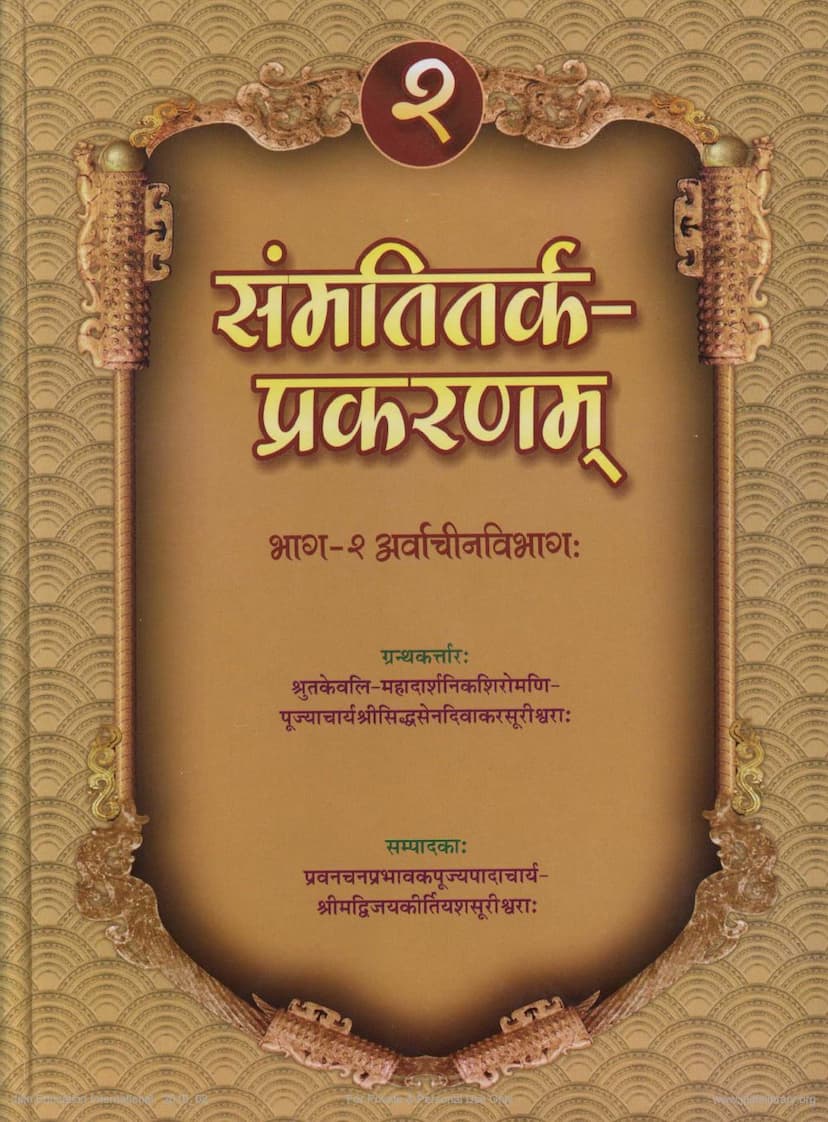Sammatitarka Prakaranam Part 2
Added to library: September 2, 2025

Summary
This document is a summary of the Jain text "Sammatitarka Prakaranam Part 2" authored by Siddhasen Divakarsuri and edited by Vijaykirtiyashsurisurishvara. The book is published by Sanmarg Prakashan.
Here's a breakdown of the key information presented in the document:
Book Details:
- Title: Sammatitarka Prakaranam (सम्मतितर्कप्रकरणम्)
- Part: 2 (भाग-२)
- Section: Arvachina Vibhagah (अर्वाचीनविभागः - indicating a section related to later or modern interpretations/commentaries)
- Original Author: Poojyacharya Shri Siddhasen Divakarasurishvara (पूज्याचार्यश्रीसिद्धसेनदिवाकरसूरीश्वराः) - described as a Shruta-kevali (श्रुतकेवली - one who has attained knowledge through listening to scriptures) and a great philosopher.
- Commentator/Translator: Poojyapadacharya Shrimadvijaykirtiyashsurishvara (पूज्यपादाचार्यश्रीमद्विजयकीर्तियशसूरीश्वराः) - described as a disciple of Poojyapadacharya Shrimadvijayramachandrasurishvara, a propagator of the teachings, and the head of the Tapagachchha.
- Publisher: Sanmarg Prakashan, Ahmedabad (सन्मार्ग प्रकाशन, अहमदाबाद)
- Edition: First Edition (प्रथमा)
- Publication Year: Vikram Samvat 2066, Vikram Samvat 2536, CE 2009.
- Price: ₹ 125/
- Print Run: 700 copies
- ISBN: 978-81-87163-59-6
Key Themes and Contents (from the Table of Contents and introductory sections):
- Focus on Logic and Philosophy: The title "Sammatitarka" itself suggests a focus on logic and reasoning within Jain philosophy. The commentary "Parshva Prabha Tikka" (पार्श्वप्रभाटीका) further emphasizes this.
- Commentary and Translation: The book is presented with a commentary (Parshva Prabha Tikka), a translation (Anvayarth - अन्वयार्थ), an explanation of the verses (Gatharth - गाथार्थ), and the essence (Tatparyarth - तात्पर्यार्थ).
- Structure of the Work: The text is divided into three Kandas (काण्ड):
- Kanda 1 (Naya Kanda - नयकाण्ड): Deals with Nayas (नय - perspectives or viewpoints in Jain logic). It discusses various Nayas like Dravastiknay (द्रव्यास्तिकनय) and Paryayastiknay (पर्यायास्तिकनय) and their interrelationships. It criticizes one-sided (ekanta - एकान्त) viewpoints.
- Kanda 2 (Upayoga Kanda - उपयोगकाण्ड): Focuses on Upayoga (उपयोग - the mode of consciousness), differentiating between Darshan (दर्शन - general perception) and Gyan (ज्ञान - specific knowledge). It delves into the debates regarding the simultaneity or succession of these in Kevalins (omniscient beings).
- Kanda 3 (Prameya Kanda - प्रमेयकाण्ड): Deals with the nature of reality (Prameya - प्रमेय), discussing concepts like cause and effect, the relationship between substance (Dravya - द्रव्य) and attributes (Guna - गुण) or modes (Paryaya - पर्याय), and the limitations of one-sided views. It also explores various philosophical standpoints like Sankhya, Bauddha, and Vaisheshika, and how Jain philosophy refutes their absolutist claims.
- Critique of Opposing Philosophies: The text aims to establish the validity of the Jain perspective (Anekanta Vada - अनेकांतवाद) by refuting other philosophical schools that present one-sided or absolutist views (Ekanta Vada - एकान्तवाद).
- The Importance of Anekanta Vada: A central theme throughout the text is the supremacy and necessity of Anekanta Vada (the doctrine of manifold aspects) for understanding reality correctly.
- Scholarly Depth: The introductory sections and the table of contents reveal a deep engagement with Jain logic, epistemology, and metaphysics, citing the works and opinions of various esteemed Jain scholars like Haribhadrasuri, Mallavadi, Abhaydevsuri, Yashovijayganivara, and others.
- Biographical Information: There are introductory sections dedicated to the life and spiritual journey of Acharya Vijay Gunyashsurishvara, the editor and commentator, and a dedication to the memory of Acharya Shrimad Vijay Ramachandrasurishvara.
In essence, "Sammatitarka Prakaranam Part 2" is a profound philosophical treatise within Jainism, meticulously analyzed and presented through the commentary of Vijaykirtiyashsurisurishvara, aiming to elucidate complex logical and metaphysical principles, ultimately advocating for the comprehensive understanding of reality through the lens of Anekanta Vada.